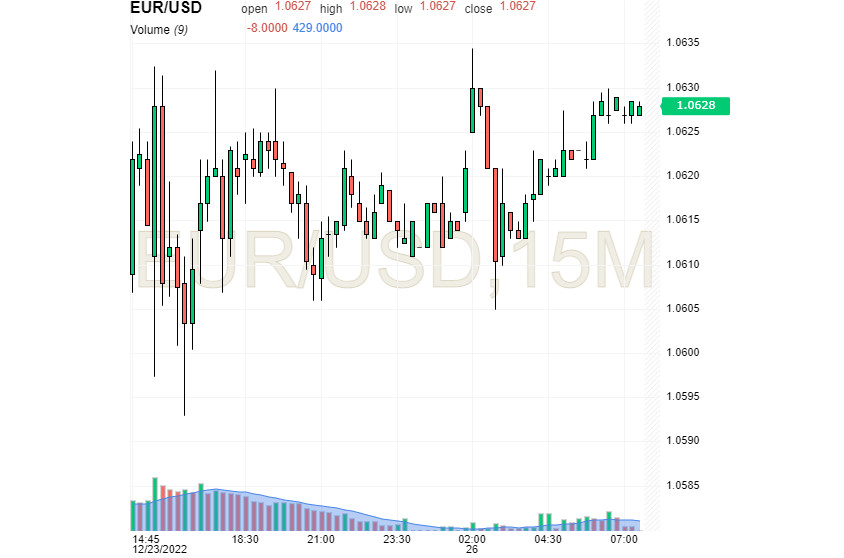
The US currency started the new week on a minor note, showing a decline. The greenback repeatedly tried to regain the lead in the EUR/USD pair, but the euro overtook it. Nevertheless, experts advise not to rest on our laurels, as the euro's victory might be short-lived.
On Monday, December 26, the dollar sharply fell against other currencies amid the New Year and Christmas holidays. Take note that stock exchanges in the US, Europe and some Asian countries were closed due to the holidays. The dollar fell during the last week of 2022, experts said. The euro took advantage of the situation and rose by 0.3% to 1.0628. On Monday morning, EUR/USD stayed in the current range of 1.0627-1.0628 trying its best to move higher.

Major market players increased the number of short positions on USD (by 23%) over the week. According to current reports on the dollar index (USDX), bearish sentiment on the dollar has increased. According to analysts' estimates, the greenback's net position has been at its lowest in 17 months. This contributes to a further decline in the dollar.
However, the current decline in the greenback doesn't provide much support to the euro. The latter is also under constant pressure, trying to resist the energy crisis and economic instability in the eurozone. According to analysts, with one week left of 2022, trading will be on a "thin" market, so the EUR/USD pair is likely to bend both in the direction of a short-term rise and decline. The pair can also rise above 1.0700 without any special reasons, and fall below 1.0500 by the end of December until the beginning of January.
Strong macro data from the US also plays an important role in the pair's dynamics. According to the U.S. Bureau of Economic Analysis (BEA) report released last Friday, December 23, inflation in America, as measured by the Personal Consumption Expenditures Index (PCE), fell to 5.5% year over year. At the same time, US new home sales rose sharply (by 5.8%), beating analysts' expectations for a low figure (-4.7%).
However, experts urge a careful analysis of the data, because not only is the slowdown in US inflation important (from 6.1% y/y to 5.5% y/y), but also the rate of its growth for the month. Recall that the core index showed a 0.2% m/m increase in prices, although previously the monthly inflation in the US was much higher (0.6% m/m). According to analysts, against this backdrop, US inflation will continue to decline.
Many experts also focus on a possible onset of a recession in America due to the Federal Reserve's monetary tightening, but this is unlikely. Positive forecasts are supported by the strengthening of US economic growth in the fourth quarter of 2022 to 3.7% per annum. The Conference Board reported that its Consumer Confidence Index rose to 108.3 in December, up from 101.4 in November, its highest level in eight months. The University of Michigan's Consumer Sentiment Index for December also surged to 58.4 points from 55.6 before being revised upward to 59.9 points, its highest level since April 2022.
In such a situation, many investors expect the Fed's rate cut, since there is a high probability of inflation showing signs of stabilizing. Under such a scenario, economic growth in the U.S. will remain moderately high, analysts believe. However, experts do not rule out that the dollar will continue its downward movement next year amid Fed rate cuts.
Such a scenario provokes the growth of risk appetite but it is not too positive for the euro. Negative forecasts contribute to the recession that engulfed the euro area, analysts emphasize. Moreover, in 2023 the European Central Bank is still going to raise the rate (by 50 bps) although in November 2022 eurozone inflation eased.
Although the ECB remains more hawkish than the Fed, this is unlikely to help the euro. According to currency strategists at Bank of America (BofA), the euro will fall in 2023 if another ECB rate hike hurts most of the euro bloc. In the new year, the eurozone will face a full-scale debt crisis, BofA emphasizes. Such a scenario would push EUR to fall below parity, experts conclude.
 Bahasa Indonesia
Bahasa Indonesia 
 Русский
Русский English
English Bahasa Malay
Bahasa Malay ไทย
ไทย Español
Español Deutsch
Deutsch Български
Български Français
Français Tiếng Việt
Tiếng Việt 中文
中文 বাংলা
বাংলা हिन्दी
हिन्दी Čeština
Čeština Українська
Українська Română
Română

